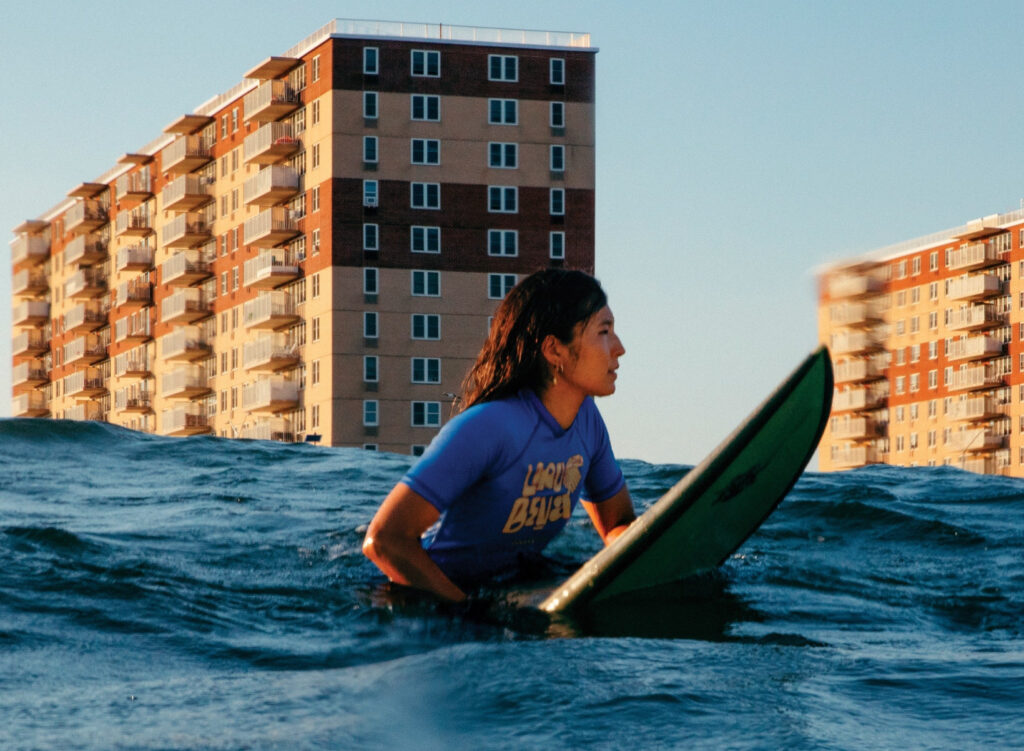A new generation of surfers and restaurateurs are remaking the outer edges of New York City—with wetsuits, breakfast burritos, and beach bars fueling the community year-round.
On a thin stretch of Atlantic coast, at the southeastern tip of Queens, something is stirring. It’s not new, exactly—but it feels like it is. Rockaway Beach, the largest urban beach in the United States, has long been a whispered-about haven among New York surfers. In 2025, it’s no longer whispered. It’s growing louder. And with every set that rolls in, more boards are dropping into the water—and more cafes and bars are rising just above the tide.
Once a well-kept secret among cold-water surf diehards and early-rising city dwellers, Rockaway’s surf scene is now part of a much larger cultural swell. The pandemic may have catalyzed it, but four years on, the movement hasn’t fizzled—it’s matured. Rockaway has shifted from niche to neighborhood. From outpost to ecosystem.
The Surf Break That Never Slept
There are roughly 13,000 permanent residents in Rockaway Beach. Many of them grew up here. Some were drawn in by the surf. Others stuck around after summer jobs or seasonal leases. But no matter how they got here, most will tell you the same thing: Rockaway doesn’t behave like the rest of New York.
Here, the subway rumbles above a dune line, seagulls circle over cafés, and surfers walk barefoot down residential blocks, boards under arm. The winter lineup, usually thinned out, has held steady post-2020. Dawn patrols in 35-degree water are no longer rare—they’re a ritual. Locals are paddling out in January, grabbing breakfast at Super Burrito by 11, and checking wind conditions over espresso by 3.
“If there’s a good swell, our business swells, too,” says Eugene Cleghorn, owner of Super Burrito, a taqueria posted up just off Beach 69th. “Even on a freezing day, people come. They surf, they eat, they stay.” Cleghorn doesn’t close for the season. He keeps the lights on year-round because the surf community doesn’t hibernate anymore.
The Covid Catalyst
The surf boom in Rockaway didn’t start with COVID-19, but it accelerated there. As indoor spaces shuttered in 2020 and 2021, people sought the open air. For New Yorkers, the beach was a rare freedom. Beginner surfers flooded the break, particularly on weekends. Locals noticed a shift—not just in numbers, but in identity.
“It became clear this wasn’t a phase,” Cleghorn says. “People bought boards. They kept coming back. They wanted to learn. They wanted to stay.”
And stay they did.
By late 2022, surf schools like Locals, owned by community figures Mike Reinhardt and Mike Kololyan (affectionately dubbed “the Mikes” or “Mayors of the Rockaways”), were fully booked. Locals is more than a surf school—it’s a hybrid cafe, board locker, and gear outlet, built for both day-trippers and diehards. It now stores over 200 boards, and welcomes newcomers with open arms and practical advice.
“We built Locals for the people just starting out, because we were those people, too,” Kololyan says. “Now, we’re just helping them plug into something that already exists.”
The Mikes also own Connolly’s, one of Rockaway’s most storied watering holes. It’s a dive bar in the best possible sense—wood-paneled, memory-soaked, and always serving frozen piña coladas. When the original owner of 30 years decided to sell, it was the Mikes who stepped in to keep the legacy alive.
Business on the Break
For Tracy Obolsky, owner of Rockaway Beach Bakery, the intersection of surfing and business is personal. She started surfing Rockaway in the mid-2010s, long before moving to the neighborhood full-time. “You’d park next to rusted-out pipes,” she recalls. “It felt like the edge of something—wild, surreal.”
Now, she’s part of the community’s rhythm. “I live and work within a 25-block radius, and in summer, I don’t leave it. Everything I need is here—waves, work, food, friends.”
Obolsky sees firsthand how the surf scene feeds the local economy. When the waves are good, her bakery gets slammed. When the tide’s high and clean, the whole boardwalk buzzes.
Other businesses feel it, too. There’s Beach Surf Club, Rockaway Tiki Bar, and Batesy’s, each catering to a distinct but overlapping crowd of surfers, creatives, and summer residents. When the swells align with sunshine, this stretch of Queens takes on the energy of a small coastal town—laid back, salt-drenched, and alive.
The New Boardwalk Economy
The Rockaway Beach Boardwalk, once quiet during the colder months, has become the backbone of the local small business revival. It’s more than a scenic walkway—it’s a corridor of commerce. Since Hurricane Sandy devastated the coast in 2012, many of the area’s most beloved eateries have helped anchor the community’s rebuild.
Places like Rippers Burger Shack, Low Tide Bar, and Caracas Arepa Bar weren’t just survivors of Sandy—they became symbols of resilience. As the boardwalk was reconstructed, these establishments helped redefine what Rockaway could be: less seasonal, more rooted, more local.
Zachary Krieger, founder of Washed Up, a pop-up cafe that operates in the warmer months, has seen the transformation firsthand. “It used to be just a few of us in the winter,” he says. “Now it’s consistent. And summer? It’s a full-on scene.”
Krieger opens early for dawn patrol surfers, sometimes serving hot drinks as the sky lightens over the Atlantic. On Friday nights, he grills burgers. Occasionally, guest chefs roll through. The model works because the surf community shows up—for the waves and for the food.
Washed Up shuts down in December and reopens in May. For Krieger, that seasonality is a strength, not a weakness. It’s a rhythm that mirrors the ocean itself.
Looking Ahead: 2025 and Beyond
The cultural shift in Rockaway isn’t slowing. According to Statista, the surf market is expected to grow by 80% between 2025 and 2032. That trajectory puts pressure—and possibility—on urban surf spots like Rockaway. And with New York City’s population rebounding, thanks to post-pandemic migration, the demand for accessible outdoor experiences is growing alongside it.
But as Rockaway expands, so do conversations around community, equity, and access. The original surf scene here was rooted in DIY ethos and unglamorous dedication. As newer, wealthier residents move in, and businesses scale to meet demand, long-timers like the Mikes and Obolsky are working to preserve the soul of the place.
“We’re not trying to gatekeep,” Obolsky says. “But we are trying to keep Rockaway Rockaway. It’s about shared space. Shared respect.”
Locals continues to host surf workshops, cleanups, and mentorship programs aimed at keeping the beach open, inclusive, and community-driven. It’s a vision that resonates with longtime residents and newcomers alike.
“When you think of surfing in New York City, it really feels like surfing in New York City,” Obolsky says with a smile. “It’s raw. It’s weird. It’s beautiful. It’s real.”
Rockaway in 2025 is more than a beach. It’s a blueprint. A hyperlocal ecosystem driven by waves and waffles, sunrise sessions and frozen piñas. It’s a reminder that even in the most concrete city in the world, there’s space for something organic to grow. Something slow. Something saltwater-soaked and built on trust.
No comments yet.








